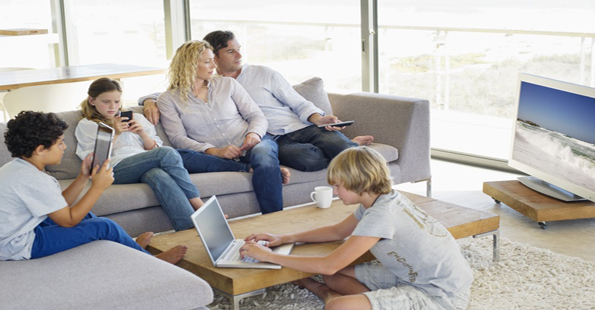veilles / 02 Juil 2012
Multi-screening encourages more TV and ad viewing

New ‘Screen Life’ research from Thinkbox reveals how TV benefits from second screens
London, 28 June 2012: Using a second screen while watching TV encourages more TV viewing and gives people more exposure to – and the opportunity to respond to – TV ads, a new study has revealed.
‘Screen Life: The View from the Sofa’ is a new study carried out for Thinkbox by COG Research and designed to help the advertising community understand the context of multi-screening (watching TV and simultaneously using an internet-connected device such as a laptop, smartphone or tablet).
The Screen Life research used a combination of research techniques. It examined over 700 hours of TV viewing gathered from filming the living rooms of 23 multi-screening households in the UK for a week. This footage then underwent psycho-physiological analysis to examine actual programme and ad break engagement. This was coupled with self-reporting from the households involved using COG’s award-winning digital ethnography technique*; a laboratory test to examine ad recognition; and online research among 2,000 people with TV and online access.
Key findings include:
Multi-screening keeps viewers present for ad breaks
•People in the sample were more likely to stay in the room or not change the channel during the ad break if they were multi-screening. Multi-screening viewers stayed in the room for 81% of ad breaks; viewers not multi-screening stayed in the room for 72%.
•31% of people in the UK (with access to TV and the internet)** have chatted about TV programmes or ads on a second screen; this rises to 56% for 16-24s
•22% chatted via text; 18% via social media; 10% via mobile messenger services.
Multi-screening encourages more TV viewing
•On average, when only one person was in the room and was multi-screening, 64% of their TV viewing sessions lasted for longer than 15 minutes. This compares to 47% when watching with no accompanying activity.
•When two people were present, as expected, due to increased interaction the figures were lower. 41% of viewing sessions were for longer than 15 minutes when multi-screening compared to 37% when watching with no accompanying activity.
Multi-screening does not affect ad recognition
•In a laboratory test where participants were invited to watch TV and/or use a laptop without being made aware they were to be tested on TV ad recognition, there was no significant difference in the level of ad recognition between people when multi-screening or only watching TV.
Multi-screening brings people closer to TV
•Participants in the Screen Life research reported that multi-screening – like other new TV technologies, such as digital recorders – makes them feel closer to TV as it enables them to research what they watch, share with online friends and participate.
Multi-screening appears to encourage more shared and family TV viewing
•Interviews with households that took part in Screen Life showed that partners and children are more likely to keep a TV viewer company if they can multi-screen – whereas previously they might have not stayed in the room.
Multi-screening is establishing itself in the living room
•People have always multi-tasked when watching TV; multi-screening is the latest accompaniment
•86% of people in the UK (with access to TV and the internet)** have ever multi-screened
•34% of the sample claim to multi-screen regularly
Neil Mortensen, Thinkbox’s Research and Planning Director: “Multi-screening is a huge benefit and opportunity for TV advertisers. Not just because it encourages people to watch more TV and more ad breaks – and does not adversely affect ad recognition – but because viewers now have the ability to act on what they see immediately. We’ve always multi-tasked in front of the TV but two screening is an incredibly complementary accompaniment.”
Thinkbox was among the first to identify and study the emerging phenomenon of multi-screening in its 2010 Tellyporting study with Decipher. This new research launches a series of Thinkbox studies under the banner of ‘Screen Life’. The series will examine the way that people interact with TV today across multiple screens. For more on Thinkbox research, visit www.thinkbox.tv.
